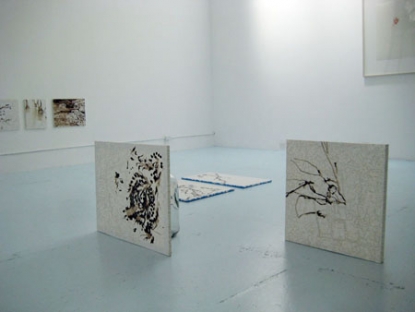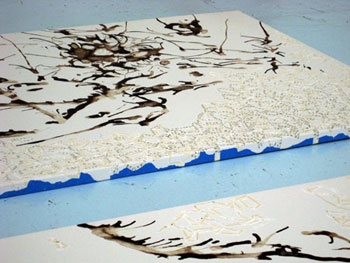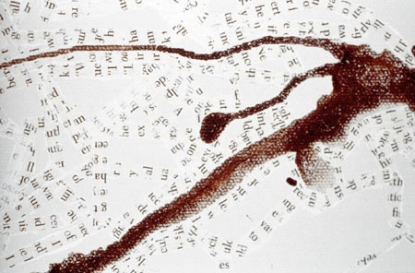
Omega Man installation shot. Foreground: Likely I Was Brought Into the World to Live With a Woman (Panels One and Two) (2007), Jordan Essoe, Blood, acrylic, tape, paper on canvas. 24 x 30" and 24" x 24 * Installation shot by Jessica Brier
Feature: Reviews
Questions upon questions
- TART
- San Francisco
- through June 23, 2007
Omega Man
Jordan Essoe
TART
Editor’s note: Jordan Essoe has written several pieces for Stretcher. These may be found by consulting our archives:
Questions upon questions. Talk upon silence. Light upon darkness upon white upon red. The many upon the very few. A canvas upon a floor. A plague upon a land upon empathy upon rage. An artist’s plea under one roof.
http://tartsf.com ">TART is deceptively clean, quiet, and bright. Jordan Essoe’s works on canvas are deceptively white.
There is a history of a world region represented here, literally and allegorically, that screams from within this body of work. But these works aren’t violent or loud; if anything, they’re serene. Tension between the poetic grace of Essoe’s exhibition Omega Man and its complex, charged political message, gives it a sense of unresolved stasis: This is where we are, Essoe seems to tell us, even though we are seemingly nowhere.
Entering the exhibition, my first instinct is to draw it. Even if you’re someone like me who doesn’t often pull out a sketchpad in galleries, you will likely feel compelled to imitate with your own hand the simple but unexpectedly playful organization of Omega Man within TART’s open but compact display, a collaborative effort between the artist and Anne Colvin, TART mastermind. Navigating the works of Omega Man only intensifies this urge.
But of course, playful is entirely the wrong word here. Essoe illustrates the history and current state of the tragic and seemingly endless Israeli-Palestinian conflict (even this phrasing reminds us of our complete inability to grasp what life is like in Israel in a way that conflates the deeply personal and the idealistically universal. If there is an argument here, it is one wrapped in philosophy. Essoe references Albert Camus’s novel The Plague and the 1971 film Omega Man, starring Charleton Heston - from which the exhibition and title piece, a 73-minute video depicting the artist as its only subject, take their names - which stand as two conflicting philosophies of human nature. Are we inherently good or evil?
The exhibition progresses in three movements. The first and most physically substantial, in both the space it occupies and the navigation it demands from viewers, is comprised of three groups of works on canvas, representing highly contested areas of Israel as a territory, all placed low to the ground, overseen by a modest watercolor of former Israeli prime minister Ariel Sharon, hung high above. Essoe describes the works on canvas as representations of the layered Israeli landscape; shreds of Camus’s The Plague plot across the works according to aerial maps of Jerusalem, the West Bank, and the Gaza Strip coupled with abstracted bloodstains encrusted on the canvases, recalling both the visible and obliterated remnants of daily acts of violence. Each piece takes its title from a phrase embedded in The Plague. Two five-gallon glass bottles sit obscured and quiet behind upright canvases bolted to the floor. Light falls from a skylight onto the portrait of the contested figure of Sharon, giving him an air of ironic religious fervor.
Rather than sensationalize the violence in Israel, Essoe insists upon its quotidian nature by staining the canvases with blood that is easily and mundanely available to him: the artist is prone to chronic nosebleeds. On the low-sitting canvases, the mingling of bloodstains, which appear to have traveled across them like roots, with the cartographic paper arrangements illustrate the contention within the works and, arguably, in the artist’s own head. Essoe has a quiet detachment from these pieces, insisting on their universality in grappling with the human condition and acknowledging his own personal distance from their subject matter. Simultaneously, this body of work consists so intimately of him. Not only does Essoe use his own body as part of his medium; perhaps more importantly, his eye is the constricted lens through which we are able to see the condition of constant violence in Israel. This is not to say that the artist is narrow-minded; we simply fall deeper and deeper into his way of feeling, politics aside. Essoe begs for empathy while the artwork begs for silent contemplation. Who is the victim and who is the perpetrator?
Around the corner, the title piece is tucked away under sunlight pouring in through another skylight. Essoe himself pours wine onto himself slowly with pained expressions, kneeling shirtless on the grassy land, framed by a fence that disappears in both directions. When he has completed this ritualistic act, inspired in part by the ancient practice of bloodletting, an effective but often lethal method of curing diseases, Essoe himself disappears and only the landscape remains without a trace of what has occurred.
Like the canvases in the front room, this piece is projected low to the ground, drawing your eye toward a small work on paper that rests on the floor in the corner of the room, recalling the visual language of the works on canvas. The title of this work on paper is perhaps the crowning question of this entire body of work: Will They Keep the Reduced Lighting as Long as the Plague Lasts? There is a short poem peppering the piece that has been whited out with acrylic paint, now only existing in Jordan Essoe’s memory.
The third and final part of the exhibition is a single piece (the only work hung at eye level), The Sower, 2007. It stands out among the rest of the work in the exhibition as perhaps the most referential to Essoe’s own position among these works. Pieces of The Plague and white acrylic paint replicate the basic form of Jean-François Millet’s iconic drawing of the same name from 1850. Perhaps unintentionally, Essoe’s re-creation of this image, chosen because the figure is immersed in the landscape, evokes a kind of knowing nod between Essoe and Millet. This quiet piece seems to imply that this poetic treatment of such brutal subject matter can only be achieved in art, cataloguing the horrors of this societal plague of violence in a way that journalism or history books can never pull off. The Sower unseats me with its simultaneous serenity and, with one clean, white line of acrylic paint that seems to pass through the figure’s head like a gunshot, a reminder of brutality in the quietest way. It’s only a horizon line, but like everything, it’s so much more than that.
A plague upon a land. Decay within the gut. A mark upon a page.
Jordan Essoe’s Omega Man at TART ran through June 23, 2007.
TART is located at 47 Lusk Alley, San Francisco, CA, 94107.
Gallery hours are 12-6 pm, Saturday, and by appointment.


